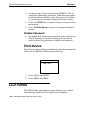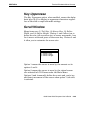
SECTION 3
Terminal Emulation Menu Screens
6400 Hand-Held Computer User’s Guide
3-43
1) Center Cursor
2) Corner Mode
3) Page Mode
4) Lazy Mode
5) Locked Mode
Screen Mode
Center Cursor
is the default mode. In this mode, the cur-
sor begins near the center of the display and attempts to
remain there as you scroll through the data. Upon reaching
an outside boundary of the full CRT screen, the display
stops advancing while the cursor m oves beyond the center
of the screen. When the cursor reaches the boundary of the
CRT screen, an error tone sounds (the hand-held computer
“beeps”). The cursor does not wrap to the next line in the
display. This option is recommended when your application
program sends the full CRT display to the hand-held com-
puter.
The
Corner Mode
option starts the d isplay at the upper-
left corner of the full CRT screen and keeps the cursor in
the lower-right corner of the display. As you scroll, the cur-
sor remains there as data advances in the scrolled direction
(up, down, right, or left)—until an outside boundary of the
full CRT screen is reached. Then the screen stops moving in
relation to the display and the cursor moves in the scrolled
direction (the c ursor no l onger remains in the corner of the
display). When the cursor reaches the CRT screen boundary
it stops moving. The cursor does not wrap to the next line in
the display. An error tone sounds if you try to move the cur-
sor beyond the boundary. This option is recommended when
your application uses only the upper-left corner of the full
CRT screen.
The
Page Mode
option divides the full CRT screen into
predefined “pages,” and starts the hand-held c omputer dis -
play on page 1. The cursor first appears in the upper-right
corner of the display. As you scroll, only the cursor moves


















